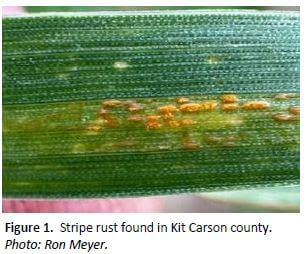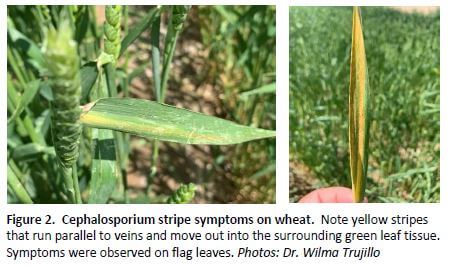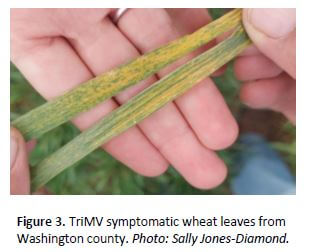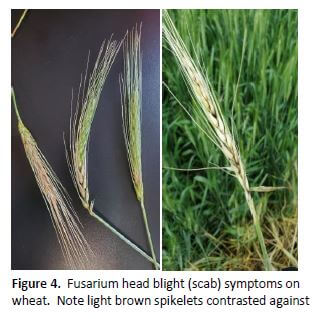Summary: Low levels of stripe rust were detected in Colorado, along with moderate levels viral diseases.
Dr. Robin Roberts – Field Crops Pathologist and CSU Assistant Professor
Robyn.Roberts@colostate.edu*, 970-491-8239
*Email is the best way to reach me

Disease Observations
Stripe Rust
Stripe rust was found in several counties at low levels (Figure 1). Stripe rust disease develops when temperatures are cooler (between 50-64°F), so the predicted heat wave this week should help suppress the disease.
Cephalosporium stripe
Cephalosporium stripe disease was observed in Washington county at low levels, sporadically across a field (Figure 2). Cephalosporium stripe is a fungal wilt disease that usually develops when there is high residue on the soil and limited or short crop rotations have been implemented. The fungus survives in wheat residue over the winter and infects crops in the spring when the weather is cool and wet. This disease has not been particularly problematic in Colorado in the past, but the unusually extended cool, wet weather has been conducive to disease development in some parts of the state.

Management and prevention: Unfortunately, there are no fungicides available to control the disease so applying fungicides will not help. Document the incidence and take note of whether there is a lot of residue build-up in your field, and if the crop was recently rotated away from wheat. The predicted warmer temperatures should also help suppress the disease.
Triticum mosaic virus:

Plants testing positive for Triticum mosaic virus (TriMV) were collected from several NE counties (Figure 3). TriMV is transmitted by the wheat curl mite, and symptoms appear as yellow streaks and mosaic patterns on leaves. In the past, TriMV was typically found when co-infected with Wheat streak mosaic virus (WSMV), but we have not yet detected any WSMV this year in Colorado (one sample from Nebraska tested positive for a TriMV+WSMV co-infection). We have observed an increasing number of TriMV-only positive samples over the past two years, so I encourage you all to stay vigilant in scouting and controlling volunteer wheat.
Management and prevention: There is no treatment for virus-infected plants, and no miticides are effective against the vector (the wheat curl mite). Controlling volunteer wheat and planting mite- resistant varieties are the best control measures. There is limited resistance available against TriMV, so controlling volunteer wheat between harvest and planting is critical.

Disease Watch and Management
Fusarium head blight (head scab)
The 2023 Field Season ended with significant Fusarium head blight (head scab, FHB, Figure 4). The fungal pathogen requires wet conditions, so FHB is more common after significant, prolonged rainfall, much like what we encountered in late May-early June last year. It prefers warm temperatures (~75-85°F), but under extended wet conditions the fungus can infect at cooler temperatures. The fungus infects flowers, so the timing of the wet, warm weather with flowering last year provided optimal conditions for disease development. So far, prediction models show that we are at low risk for FHB across the state. Penn State University and colleagues at the Fusarium Scab Initiative have developed a risk assessment tool to predict the likelihood of FHB. Colorado is currently in a low-risk category for disease development.
Additional resources
- Colorado Wheat Entomology Newsletter: https://coloradowheat.org/category/news-events/wheat-pest-and-disease- update/
- Fusarium risk tool: https://www.wheatscab.psu.edu/?ct=YTo1OntzOjY6InNvdXJjZSI7YToyOntpOjA7czo1OiJlbWFpbCI7aToxO2k6NjM7fXM6NToiZW1haWwiO2k6NjM7czo0OiJzdGF0IjtzOjIyOiI2NjA1OWYxMzk5MmJjMzY4ODcyMDIyIjtzOjQ6ImxlYWQiO3M6MjoiMjAiO3M6NzoiY2hhbm5lbCI7YToxOntzOjU6ImVtYWlsIjtpOjYzO319
- Fusarium article, Uncommon Wheat Disease in the Nebraska Panhandle in 2023: https://cropwatch.unl.edu/2024/uncommon-wheat-disease-nebraska-panhandle- 2023?utm_source=University+of+Nebraska-Lincoln+CropWatch&utm_campaign=41a18a2c0f- EMAIL_CAMPAIGN_2020_08_14_COPY_01&utm_medium=email&utm_term=0_d184080585-41a18a2c0f-137130681
- Information about the ‘green bridge’ and risks for viral diseases due to volunteer wheat: https://eupdate.agronomy.ksu.edu/article_new/spring-emerged-volunteer-wheat-should-producers-worry-about-wheat- streak-mosaic-virus-and-the-green-bridge-436-4
- Fungicide Efficacy for Control of Wheat Diseases Table: https://cropprotectionnetwork.org/publications/fungicide-efficacy- for-control-of-wheat-diseases
Do you have a disease that you would like diagnosed? Contact the Plant Health Clinic for sample submission: https://plantclinic.agsci.colostate.edu/ or csuplantlab@colostate.edu.
Contributors: Many thanks to Sally Jones-Diamond, Tyler Benninghoven, Ron Meyer, and Dr. Esten Mason who contributed to this report.